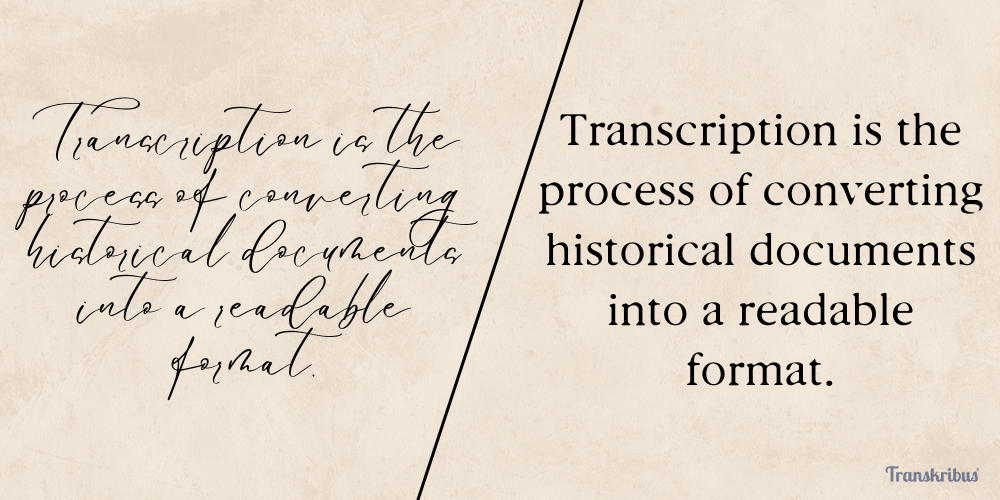.png?width=1280&height=720&name=Training%20a%20custom%20model%20v2%20(1).png)
Transcription vs Translation
Do I need to transcribe or translate handwritten text to be able to work with it? Well, that depends on your situation.
If you have a text written in a language that you don’t understand, then you would require a translation of it. If you have a text in a language that you are technically able to speak, but which is written in a script that you cannot read because, e.g., the handwriting is too old and illegible – then you need a transcription.
This article explores the differences between transcription and translation, and how the AI-powered text recognition software Transkribus can be a valuable tool in both processes.

What is transcribing?
The term “transcription” comes from the Latin word “transcribere”, which essentially means to transfer or rewrite something in writing. While traditionally associated with converting spoken text into written form, its broader sense involves transforming various information types into written text. In particular, when it comes to handwriting, transcription means converting the letters of handwritten texts into another, usually modern, script or letters.
Transcribing is an essential part of working with historical manuscripts or archival material, where the handwriting may be difficult to decipher. Converting handwritten or printed text into a digital, machine-readable format improves accessibility and searchability and allows for various forms of analysis. Tools such as the AI-powered software Transkribus provide automatic text recognition, making your transcription work both easier and more efficient!
What is translating?
As an everyday concept, the term translation refers to the process of converting written text (or spoken content) from one language into another, while retaining its meaning, context and intended communication.
However, in translation studies, there is more than one understanding of the term. Roman Jakobson, for instance, a Russian-American linguist, differentiates between three types of translation: interlingual (between different languages), intralingual (within one language) and intersemiotic (between different sign systems).
As you can see, the term covers a much broader spectrum of activities than one might have thought. But, for the sake of simplicity, let’s stick to the everyday understanding of translation for now: conveying meaning from

Benefits of using Transkribus
All complex definitions and concepts put aside, Transkribus, our AI-based platform for text recognition can help with both, transcribing and translating documents of all kinds. And it is particularly useful when working with handwritten text.
How to transcribe handwritten text
There are two ways to transcribe handwritten documents. By reading the text yourself and transcribing the documents manually, or by using a tool such as Transkribus to transcribe them automatically with the help of AI.
Transkribus is first and foremost a tool designed to support the work with historical documents by simplifying the process to make them readable, editable and searchable.
- Simply create a free account, take a photo of your documents with a smartphone and upload it to the app.transkribus.eu.
- Select a suitable public text recognition model and quickly get a machine-readable transcription. No matter how old the writing or spelling, Transkribus’ custom AI models can be trained to modernise your transcription output!
- Use the platform’s editor to streamline the editing process, ensuring accuracy and contextual understanding.
The great thing is that Transkribus works with both printed and handwritten texts. From manuscripts to newspapers, Transkribus can automatically recognise whatever historical document you are working with.
But how does this help with translation? Let’s look into the process of translating historical documents to answer this question.

Transkribus Editor
How to translate handwritten text
One of the most important first steps in the process of translating old documents is being able to decipher them, as historical scripts can be challenging to read even for people familiar with the language, whether it’s handwritten or printed text.
Just to be clear, Transkribus is not (yet) able to translate text from one language to another, but the automatic transcription creates a digital and machine-readable version of your handwritten text.
- Start the translation process of handwritten documents with an automatic transcription using Transkribus instead of an error-prone manual one, so you can save time and effort while achieving a more accurate translation output.
- Transkribus users can already make corrections, add annotations or adjust the content using the editor within the platform before starting the translation process, which helps to maintain accuracy and context.
- And, most importantly, because the transcribed text is machine-readable, processing it with computer-assisted translation tools or machine translation is much easier! Whether you are working on historical texts or contemporary ones, this is equally useful.
Providing digital versions of sources is transforming the accessibility of research materials, notes Robert Klugseder. He highlights Transkribus’ contribution to the democratisation of knowledge as it enables scholarly materials to be translated into different languages, benefiting researchers, educators and students.
Transkribus in practice
Wondering if Transkribus is really as effective in practice? Well, our many success stories are a testament to its value!
Following historical clues, William Barton was able to locate a long-hidden literary treasure, the secret diary of Karl Benedikt Hase, a rather infamous professor of Greek philology in the 19th century. And with the help of Transkribus, Barton and his team could finally transcribe as well as translate it!
Meanwhile, Jessica Sherrill is using Transkribus to research the life of the gifted mathematician, musician and poet Ada Lovelace, who is considered to be the first computer programmer. Sherrill has been working to improve access to the Lovelace Archive, offering a deeper insight into Lovelace’s remarkable life and achievements.
As these projects show, Transkribus is proving to be not only a powerful tool for unlocking the written past, but also a catalyst for overcoming language barriers and opening up access to knowledge! To start your journey, go to app.transkribus.eu or visit transkribus.org for more information.


.png?width=1280&height=720&name=Featured%20Image%20(11).png)